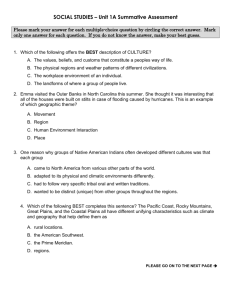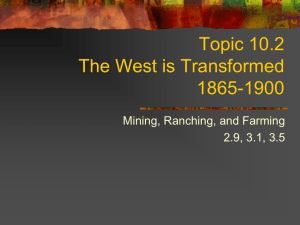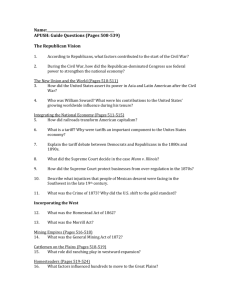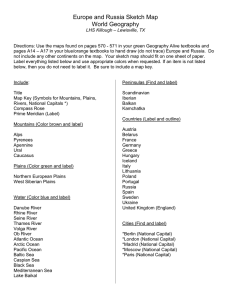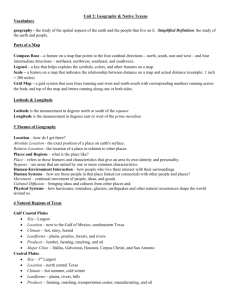Sustainability in the Southern High Plains
advertisement
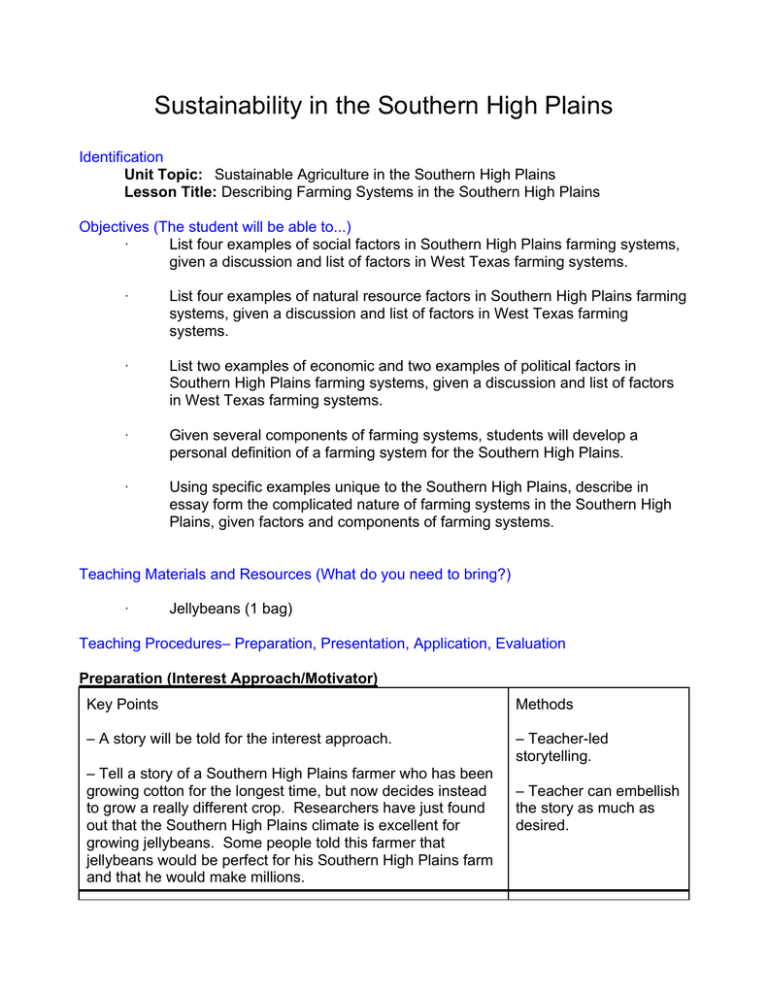
Sustainability in the Southern High Plains Identification Unit Topic: Sustainable Agriculture in the Southern High Plains Lesson Title: Describing Farming Systems in the Southern High Plains Objectives (The student will be able to...) · List four examples of social factors in Southern High Plains farming systems, given a discussion and list of factors in West Texas farming systems. · List four examples of natural resource factors in Southern High Plains farming systems, given a discussion and list of factors in West Texas farming systems. · List two examples of economic and two examples of political factors in Southern High Plains farming systems, given a discussion and list of factors in West Texas farming systems. · Given several components of farming systems, students will develop a personal definition of a farming system for the Southern High Plains. · Using specific examples unique to the Southern High Plains, describe in essay form the complicated nature of farming systems in the Southern High Plains, given factors and components of farming systems. Teaching Materials and Resources (What do you need to bring?) · Jellybeans (1 bag) Teaching Procedures– Preparation, Presentation, Application, Evaluation Preparation (Interest Approach/Motivator) Key Points Methods – A story will be told for the interest approach. – Teacher-led storytelling. – Tell a story of a Southern High Plains farmer who has been growing cotton for the longest time, but now decides instead to grow a really different crop. Researchers have just found out that the Southern High Plains climate is excellent for growing jellybeans. Some people told this farmer that jellybeans would be perfect for his Southern High Plains farm and that he would make millions. – Teacher can embellish the story as much as desired. – The farmer thought this was the perfect idea and was very excited about making millions. Everything was going OK until the farmer started to ask himself these questions. – Who else in the area grows jelly beans? – Can I get a loan to grow jelly beans? Insurance? – What will other farmers think of me if I grow jelly beans? – What equipment will I need? Cost of equipment? – Are there government subsidies for jelly beans? – How will I irrigate? – What impacts on the soil will jelly beans have? – How can I transport jelly beans to sell them? – Who will buy these jelly beans? – What political implications are there? – What labor will be required? – After the farmer asks himself all of these questions, do you think that this idea of growing jelly beans is still such a good idea? – Was this idea more complex than the farmer originally perceived? –Today we will discuss: – Social factors in Southern High Plains farming systems – Natural resource factors in Southern High Plains farming systems – Economic factors in Southern High Plains farming systems – Political factors in Southern High Plains farming systems – Definitions of Southern High Plains farming systems – Complexity of farming systems – Oral questioning. – Emphasize the complexity involved in this decision. – Review objectives. Presentation (The Content) Key Points Methods – Begin by explaining that the components of the Southern High Plains farming systems are similar to that of the example of the third-world country farming system, with a few differences. – Teacher-led lecture. – What are the broad components of Southern High Plains farming systems? – Teacher questioning. Direct students to give these answers: social, natural, economic, and political. – After briefly explaining components and of Southern High Plains farming systems broadly, get more specific and ask for specific examples of social factors unique to the Southern High Plains. – Give students that contribute to discussion a few jellybeans. – Ask for specific examples of natural resource factors unique to the Southern High Plains. – Ask for specific examples of economic factors unique to the Southern High Plains. – What are social factors in the Southern High Plains? – Write responses on board and in student workbook and discuss each social factor, briefly focusing on its implication to the Southern High Plains. – What are natural resource factors in the Southern High Plains? – Write responses on board and in student workbook and discuss each resource factor, briefly focusing on its implications to the Southern High Plains. – What are economic factors in the Southern High Plains? – Ask for specific examples of political factors unique to the Southern High Plains. – Write responses on board and in student workbook and discuss each economic factor, briefly focusing on its implication to the SHP. – What are political factors in the Southern High Plains? – Have students develop their own definition of a Southern High Plains farming system. – Write responses on board and in student workbook and discuss each political factor, briefly focusing on its implication to the SHP. – Write on the board “A Southern High Plains farming system is...” and have students fill in the rest of this statement in their student handbook. Application (What will they do with what you taught?) Key Points Methods – Have students write an essay describing the complexity of Southern High Plains farming systems that could be given to producers who are thinking about changing their farming operation. – Teacher-led student writing assignment. – Have students write essay in workbook. – Emphasize the importance of realizing the complexity involved with farming systems. Have students think about applications that this complexity presents to their community and families. Evaluation (How do you know they learned it?) Key Points Methods – What are some social factors of Southern High Plains farming systems? – What are some natural resource factors of Southern High Plains farming systems? – What are some economic factors of Southern High Plains farming systems? – What are some political factors of Southern High Plain farming systems? – Why is knowing farming systems important to the Southern High Plains? – Teacher-led oral questioning. – Finish with a lead into family components of farming systems. The idea of family components might have been previously brought up by the students. Explain that family components of the farm might be an even larger factor than – Summary– Lead-in for tomorrow. any previously discussed factors of farming systems.
